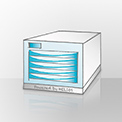HELIOS Tech Info #068
Server security / Sharing HELIOS volumes over the Internet
Following are the HELIOS TCP/IP ports used by the different product modules:
Port Protoc. Where Function110 TCP Server EtherShare POP 3 E-Mail server137 UDP Server Name Binding WINS138 UDP Server PCShare Browsing139 TCP Server PCShare SMB/CIFS427 UDP Server HELIOS Base SLP server445 TCP Server PCShare SMB/CIFS515 TCP Server BSD Remote LPR548 TCP Server AFP Server2000 UDP Server PCShare native DOS/Win 3.x2001 TCP Server EtherShare Mail server2001 UDP Server PCShare native DOS/Win 3.x2002 TCP Server ImageServer event listener port2003 TCP Server PCShare telnet service port2004 TCP Server EtherShare Admin2005 TCP Client Create PDF Server2006 TCP Server Reserved for future HELIOS Admin2007 TCP Server EtherShare print spooler (papsrv)2011-2014 TCP Client Printing PCShare native DOS printsrv2021-2023 TCP Client Printing PCShare native DOS printsrv2222 UDP Server EtherShare RPC2223 UDP Server PCShare RPCnetstat -a | grep -i listen command. This article will focus only on the options of HELIOS services. One option to bring some services into the Internet is to use two network adapters, one for the Intranet and a second for the Internet, e.g.:Interface addressle0 172.16.0.1 Intranet networkle1 193.141.98.37 Internet networkPlease note:
allow 172.16.0.0/255.255.0.0 #Intranet Networkdeny 0.0.0.0/0# prefvalue -k Programs/afpsrv/ipaccess -t str ipaccess.publicallow 172.16.0.0/255.255.0.0 #Intranet Networkallow 193.141.98.37/255.255.255.0 #Internet Networkdeny 0.0.0.0/0allow 172.16.0.0/255.255.0.0 #Intranet Networkdeny 0.0.0.0/01. /pub/www/webtransfer2. /data1/production3. /data2/sales# prefvalue -k Volumes//pub/www/webtransfer/IPAccess -t str ipaccess.public# prefvalue -k Volumes//data1/production/IPAcess -t str ipaccess.private# prefvalue -k Volumes//data2/sales/IPAcess -t str ipaccess.privatePlease note:
Some additional Q&A concerning IP access in HELIOS products:
|
Q: |
|
How to enable guest login for the “afpsrv”? |
|
A: |
|
|
|
Q: |
|
What is the difference between the “ipaccess” and “IPAccess” preference? |
|
A: |
“ipaccess” is for all server processes, e.g. “pcshare”, “afpsrv”, “opisrv”, “slpsrv”, etc. whereas “IPAccess” is a per-volume preference. For details see HELIOS Base 1.1 manual, section 4.5.3 |
|
|
Q: |
|
Is the per-volume “IPAccess” preference available for EtherShare and PCShare? |
|
A: |
At present only for EtherShare; PCShare will support it with a future update or version. |
|
|
Q: |
|
Can I have auditing for the “webtransfer” volume? |
|
A: |
Yes. The “server.acct file” will show all logins. Another option is to turn on the “xferlog” preference to log I/O file activity. For details see HELIOS Base 1.1 manual, section 7.1. Use this option with care since it causes considerable load on the server and should not be used on production servers. |
|
|
Q: |
|
Can I publish a Macintosh printer queue on the Internet? |
|
A: |
Yes. Use our TCP/IP printer drivers for remote Mac OS 9 or Mac OS X clients, publish the printer queue via TCP on a custom port, e.g.:
will publish it on port 8000. Enable the port on your Internet firewall to be forwarded to port 8000 to the server. |
|
|
Q: |
|
Can I use the IP access for the Remote LPR protocol? |
|
A: |
Yes. By default the “lpd” uses the “HELIOSDIR/var/conf/ipaccess” file. For details see HELIOS Base 1.1 manual, section 10.7 |

 Enterprise Fileserver
Enterprise Fileserver
 Entwickler / SDK
Entwickler / SDK
 Handel / Industrie
Handel / Industrie
 Zeitungen / Verlage
Zeitungen / Verlage
 Fotografen / Studios
Fotografen / Studios
 Werbeagenturen / Mediendienst- leister / Druckereien
Werbeagenturen / Mediendienst- leister / Druckereien
 Video & Entertainment
Video & Entertainment
 Cloud-Zusammenarbeit
Cloud-Zusammenarbeit
 HD Color
HD Color
 Bildverarbeitung
Bildverarbeitung
 Proofs
Proofs
 WebShare Portal
WebShare Portal
 Automatisierung von Workflows
Automatisierung von Workflows
 Fileserver
Fileserver
 Pressetexte
Pressetexte  Videos
Videos  Newsletter
Newsletter  Veranstaltungen
Veranstaltungen